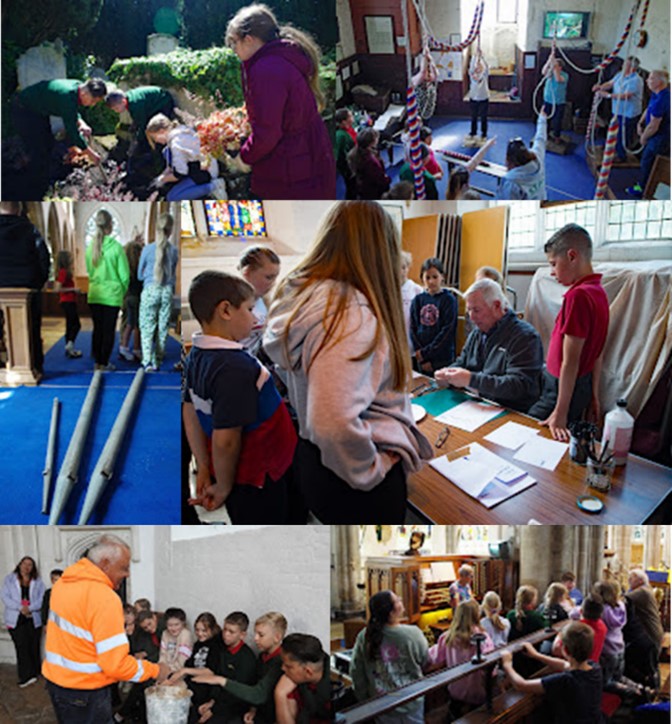 Church buildings are a fantastic resource for enriching school curriculums.
Church buildings are a fantastic resource for enriching school curriculums.
Most parish churches already have a close relationship with their local school through services and teaching RE and history, but there is so much more potential.
Churches can be used to teach a range of subjects from art and photography to literacy and STEM (Science, Technology, Engineering and Mathematics). They are great spaces to use to practice public speaking; churchyards can be used to teach about wildlife and gardening; and repair projects offer an opportunity for children to learn about heritage careers.
Last month, pupils from The Orchards School in Wisbech visited St Peter and St Paul’s church to learn about some of the careers connected to and inspired by church buildings. About 60 pupils and their teachers took part in 5 special activities to explore gardening, bellringing, stonemasonry, paper sculpture and playing the organ. This was part of a major project supported by the National Lottery Heritage Fund.
The garden teams joined Wisbech in Bloom volunteers to weed, plant and generally revive the beach themed garden which had been impacted by building works. Although there were some initial reservations about getting their hands dirty in the soil, all the pupils got stuck in and did a great job!
“…how fascinating a bucket of seashells is to people who rarely get the chance to go to the beach...”
Up the narrow stairs to the bell tower, the second activity gave everyone the chance to have a go at chiming a bell and ringing handbells (harder than it looks!).
At the Harrison organ, one of the finest in East Anglia, pipes were carefully removed so pupils could look inside and blow through them to check whether the bigger the pipe, the deeper the sound. The organist then played the theme tune to Harry Potter, which made the church feel like part of Hogwarts.
The fourth activity involved Steve the Stonemason who has been working on the church repairs for the last two years. Pupils learnt about mixing lime and had a go at stone carving.
The fifth activity was somewhat more relaxed, as pupils made paper angels inspired by those depicted in the stained-glass windows. These were taken home to provide a memento of their amazing day out. The church volunteers waved the school goodbye and had a well-earned cup of tea and a sit down.
The day was a great success, with teachers commenting on the positive experience for pupils:
- Children were able to learn from skilled and professional people in their community – the Headteacher mentioned this as opening up children’s minds to different work that they are not exposed to normally.
- Children learnt about aspects of the church in the past and today through ‘doing’ and sharing with other adults in the community, including wider teams at the church e.g. the bell ringers and local volunteers from Wisbech in Bloom.
This event was part of a bigger project engaging with six local schools in the area, which has required a lot of volunteer support. There was some initial hesitancy, but once people realised what a joy it was working with children and celebrating the heritage of their church, the numbers quickly grew. The project evaluator has commented that “it was lovely to see how easily the children took to volunteers and felt welcomed” and noted the growing confidence for some volunteers working with children. Staff from the school have asked for it to be an annual event and church volunteers are committed and excited to continue.
You can read more about this project and all the work going on at St Peter and St Paul’s via the project blog here. You can see more photographs of the activity sessions on the Fenland Citizen website here.
Of course, not every church has the resources or opportunity to deliver something on this scale, but that doesn’t mean there aren’t ways you can engage with local schools.
- Contact staff to find out which parts of the curriculum or groups of children a visit to the church could help enrich.
- Work with teachers to build their confidence in using your church building
- Provide some self-led activities such as trails and worksheets.
- If you are planning repairs, liaise with your architect, builder, heritage specialist etc... to see if they would be happy to work with a visiting school.
- Could you involve schools in maintenance days, conservation cleaning activities, writing guidebooks, creating posts for social media, creating wildlife spaces in your churchyard etc...?
- If you have someone interested in taking things further, consider a grant from the National Lottery Heritage Fund – engaging school children in local heritage activities is something that they do love to support!
More advice
If you’d like more advice about working with schools please contact Holly Isted, Historic Church Buildings Support Officer. And remember, even if you don’t have a school nearby, if you are looking for ways to bring new people into your church, try using your building’s assets – the history, heritage, art and architecture – to engage with people.
“People just come in, they see a lovely building and want to have a look at it – they may bump into God while they are here” - Churchwarden
